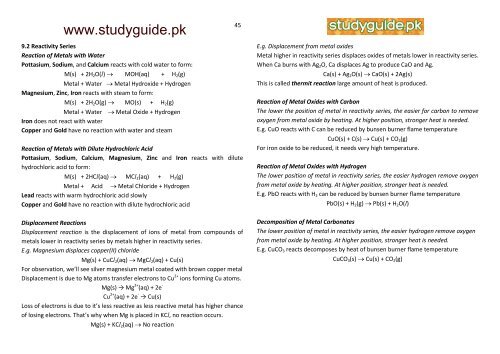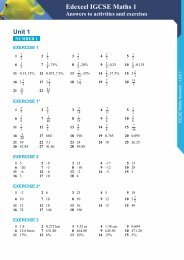O-Level-Chemistry-Notes
O-Level-Chemistry-Notes
O-Level-Chemistry-Notes
Create successful ePaper yourself
Turn your PDF publications into a flip-book with our unique Google optimized e-Paper software.
www.studyguide.pk<br />
Copyrights AF/PS/2009/2010 45<br />
9.2 Reactivity Series<br />
Reaction of Metals with Water<br />
Pottasium, Sodium, and Calcium reacts with cold water to form:<br />
M(s) + 2H2O(l) MOH(aq) + H2(g)<br />
Metal + Water Metal Hydroxide + Hydrogen<br />
Magnesium, Zinc, Iron reacts with steam to form:<br />
M(s) + 2H2O(g) MO(s) + H2(g)<br />
Metal + Water Metal Oxide + Hydrogen<br />
Iron does not react with water<br />
Copper and Gold have no reaction with water and steam<br />
Reaction of Metals with Dilute Hydrochloric Acid<br />
Pottasium, Sodium, Calcium, Magnesium, Zinc and Iron reacts with dilute<br />
hydrochloric acid to form:<br />
M(s) + 2HCl(aq) MCl2(aq) + H2(g)<br />
Metal + Acid Metal Chloride + Hydrogen<br />
Lead reacts with warm hydrochloric acid slowly<br />
Copper and Gold have no reaction with dilute hydrochloric acid<br />
Displacement Reactions<br />
Displacement reaction is the displacement of ions of metal from compounds of<br />
metals lower in reactivity series by metals higher in reactivity series.<br />
E.g. Magnesium displaces copper(II) chloride<br />
Mg(s) + CuCl2(aq) MgCl2(aq) + Cu(s)<br />
For observation, we’ll see silver magnesium metal coated with brown copper metal<br />
Displacement is due to Mg atoms transfer electrons to Cu 2+ ions forming Cu atoms.<br />
Mg(s) → Mg 2+ (aq) + 2e -<br />
Cu 2+ (aq) + 2e - → Cu(s)<br />
Loss of electrons is due to it’s less reactive as less reactive metal has higher chance<br />
of losing electrons. That’s why when Mg is placed in KCl, no reaction occurs.<br />
Mg(s) + KCl2(aq) No reaction<br />
E.g. Displacement from metal oxides<br />
Metal higher in reactivity series displaces oxides of metals lower in reactivity series.<br />
When Ca burns with Ag2O, Ca displaces Ag to produce CaO and Ag.<br />
Ca(s) + Ag2O(s) CaO(s) + 2Ag(s)<br />
This is called thermit reaction large amount of heat is produced.<br />
Reaction of Metal Oxides with Carbon<br />
The lower the position of metal in reactivity series, the easier for carbon to remove<br />
oxygen from metal oxide by heating. At higher position, stronger heat is needed.<br />
E.g. CuO reacts with C can be reduced by bunsen burner flame temperature<br />
CuO(s) + C(s) Cu(s) + CO2(g)<br />
For iron oxide to be reduced, it needs very high temperature.<br />
Reaction of Metal Oxides with Hydrogen<br />
The lower position of metal in reactivity series, the easier hydrogen remove oxygen<br />
from metal oxide by heating. At higher position, stronger heat is needed.<br />
E.g. PbO reacts with H2 can be reduced by bunsen burner flame temperature<br />
PbO(s) + H2(g) Pb(s) + H2O(l)<br />
Decomposition of Metal Carbonates<br />
The lower position of metal in reactivity series, the easier hydrogen remove oxygen<br />
from metal oxide by heating. At higher position, stronger heat is needed.<br />
E.g. CuCO3 reacts decomposes by heat of bunsen burner flame temperature<br />
CuCO3(s) Cu(s) + CO2(g)



